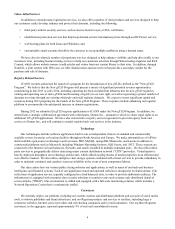Enom 2012 Annual Report Download - page 21
Download and view the complete annual report
Please find page 21 of the 2012 Enom annual report below. You can navigate through the pages in the report by either clicking on the pages listed below, or by using the keyword search tool below to find specific information within the annual report.16
that are generally one to two years in length. Our customers have no obligation to renew their contracts for our products after
the expiration of their initial commitment period, and these agreements may not be renewed at the same or higher level of
service, if at all. In addition, these agreements generally require us to keep our product suite operational with minimal service
interruptions and to provide limited credits to media customers in the event that we are unable to maintain these service levels.
To date, service level credits have not been significant. Moreover, under some circumstances, some of our customers have the
right to cancel their service agreements prior to the expiration of the terms of their agreements, including the right to cancel if
our social media product suite suffers repeated service interruptions.
If we are unable to attract new customers for our media products and services, including our content channels service
offering and our social media products, our existing customers do not renew or terminate their agreements or we are required to
provide service level credits to our social media customers in the future as a result of the operational failure of our social media
products, then our operating results could be harmed.
Wireless devices and mobile phones are increasingly being used to access the Internet, and our online media services may
not be as effective when accessed through these devices, which could cause harm to our business.
Historically, our Content & Media service offerings were designed for consumption on a desktop or laptop computer.
However, the number of people who access the Internet through mobile devices such as smart-phones and tablets has increased
substantially in the last few years. The smaller screens, lower resolution graphics and less convenient typing capabilities of
these devices may make it more difficult for visitors to respond to our offerings. If we cannot effectively distribute our content,
products and services on these devices, we could experience a decline in page views and corresponding revenue. In addition,
while increasing rapidly, mobile advertising yields on average are currently lower than those for desktop and laptop devices.
The continued increase in mobile consumption of our content, should it replace page views from desktop or laptop devices,
may result in a reduction in our RPMs and/or Content & Media revenue. Also, if our Content & Media service offering on
mobile devices is less attractive to advertisers and this segment of Internet traffic increases at a faster rate than traditional
desktop or laptop Internet access our business, revenue, financial condition and results of operations may be negatively
impacted.
We are dependent upon the quality of traffic in our network to provide value to online advertisers, and any failure in our
quality control could have a material adverse effect on the value of our websites to our third-party advertisement
distribution providers and online advertisers and thereby adversely affect our revenue.
We use technology and processes to monitor the quality of, and to identify any anomalous metrics associated with, the
Internet traffic that we deliver to online advertisers and our network of customer websites. These metrics may be indicative of
low quality clicks such as non-human processes, including robots, spiders or other software; the mechanical automation of
clicking; and other types of invalid clicks or click fraud. Even with such monitoring in place, there is a risk that a certain
amount of low-quality traffic, or traffic that is deemed to be invalid by online advertisers, will be delivered to such online
advertisers. As a result, we may be required to credit future amounts owed to us by our advertisers. Furthermore, low-quality or
invalid traffic may be detrimental to our relationships with third-party advertisement distribution providers and online
advertisers, and could adversely affect our revenue.
The expansion of our owned and operated websites into new areas of consumer interest, products, services and technologies
subjects us to additional business, legal, financial and competitive risks.
An important element of our business strategy is to grow our network of owned and operated websites to cover new areas
of consumer interest, expand into new business lines and develop additional services, products and technologies. In directing
our focus into new areas, we face numerous risks and challenges, including increased capital requirements, long development
cycles, new competitors and the requirement to develop new strategic relationships. We cannot assure you that our strategy will
result in increased net revenue or net income. Furthermore, growth into new areas may require changes to our existing business
model and cost structure, modifications to our infrastructure and exposure to new regulatory and legal risks, any of which may
require expertise in areas in which we have little or no experience. If we cannot generate revenue as a result of our expansion
into new areas that are greater than the cost of such expansion, our operating results could be harmed.
























